
By Krista Spence
I have been using ideas from the text, Natural Curiosity, 2nd edition (2017), as a foundation for my work with elementary students during their visits to the library. Over the past three years, I have worked with various members of Indigenous and non-Indigenous communities to restore the land around our school and to create spaces where children and adults can develop a relationship with the land. This means observing the changes, learning about the relationships between plants, animals, insects, sun, water, wind and learning about being active participants in the space, supporting life in all its forms.
By tending a garden of Indigenous medicinal plants in front of the library, introducing a forest, a meadow and wetland in what was once a small courtyard, and maintaining nine raised planter beds for herbs and vegetables in a bright driveway, we have created three distinct areas to learn from on our urban, downtown school grounds. Each plant that is introduced to the space has been chosen based on how it connects to the everything around it, and the learning opportunities that it presents.
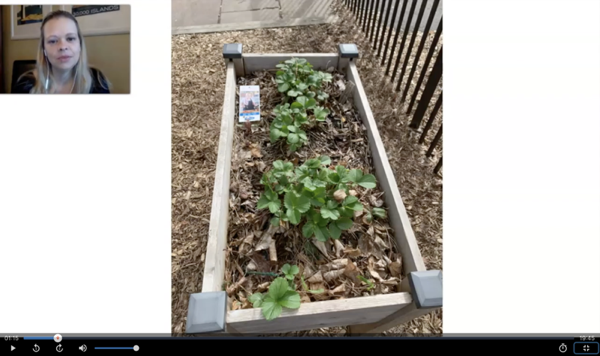
Although we have moved to an online model of teaching during this spring term, due to COVID, I didn’t want to give up on the goal of connecting students with nature, and to help them see the connections all around them, no matter where they are physically located. Bringing Indigenous perspectives and viewpoints to these topics is also of utmost importance and a foundational goal of my library curriculum. I knew this would present a challenge when moving all of our teaching and learning online.
One of the lovely things about the goal of connecting students to the land, and incorporating Indigenous perspectives is that it applies to everyone, no matter their age or developmental stage. Anyone and everyone can enter into a relationship with the natural world around them. The natural world can provide consistency, beauty, and solace, when other aspects of our lives are tumultuous, ever-changing and in our digital world, can be quite abstract and feel disconnected. Through connecting children with the natural world, even through videos, I felt that this modelling of relationship to the land could inform them in their own interactions with nature. I watched Alan Colley, of Toronto Aboriginal Eco Tours, during a Facebook live event, teach about some of the native plants and animals around the Humber River and saw how the connection with nature could be taught remotely. Of course, best would be in person, and in real life, but for now, this is the platform available for teaching in a safe way.
I went to our school grounds, and during this exciting spring season, filmed various plants and posed questions as well as shared information about them. We planted strawberries in a planter last year that have come back, and provided for grounding a great lesson on ‘Heartberries’, and the way that our heart is in the center of all that we do. In Natural Curiosity, Part 1 Lighting the Fire: The Spirit of Learning, people are encouraged to speak from the heart, and the teachings about strawberries are connected to this idea. I picked up a document that included a Strawberry Teaching from the Wabano Centre for Aboriginal Health, in Ottawa, Ontario.
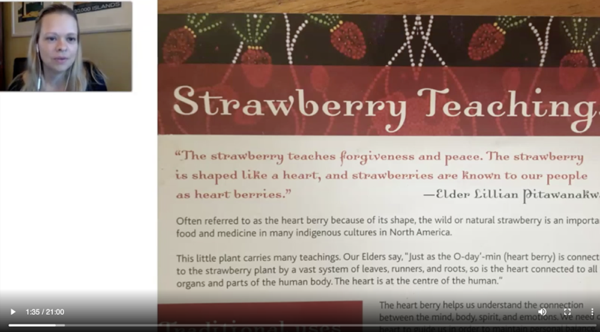
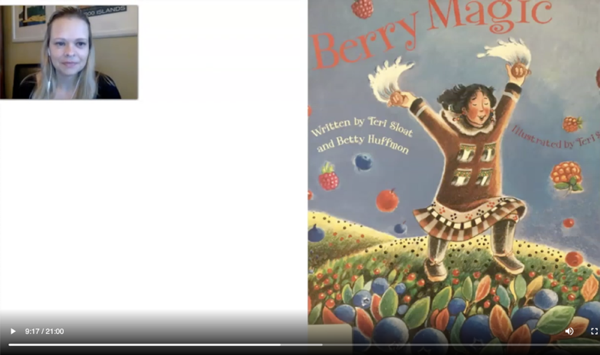
I paired these teachings with a picture book Berry Magic by Betty Huffman and Teri Sloat. Berry Magic was written in collaboration and the authors’ notes about how they went about writing it were very important. In it, they honoured the process of writing the story, of ensuring they ‘get it right’, and in consultation with the knowledge keepers of the Yup’ik community, whose traditional territory is in Alaska. I shared a map of the location, and found clips of traditional dancing. The clothing and special ceremonial elements were accurately represented in the story, too. I always try to feature lived, modern videos showing how traditions are honoured and passed down. I also found a great video of the young man, Byron Nicholai, singer and drummer, who identifies as Yup’ik, who talked about stepping up and taking the responsibility of drumming and singing, when his older cousin graduated from high school. This is a way that I try to lift up others as teachers, who cannot be in the room. Theirs are the voices the students should hear from to learn about their lived culture.

Following lesson connected with Natural Curiosity’s Branch 1 “Lighting the Fire: the Spirit of Learning”, featured stories that help students understand natural processes and to raise their awareness and curiosity of things they may or may not have noticed around them. For example, Planting the Wild Garden by Kathryn O. Galbraith is a beautiful picture book, with so many rich illustrations that show all different ways that a meadow is naturally planted. It describes the many ways that seeds ‘move’, by wind, by water, by animal, by humans, in order to create new life. This understanding that planting is a highly specialized and sophisticated process, bound to the environment around it, gives a new perspective on the burrs the children might pick out of their pet’s fur, or from their own socks.
The Second Branch of Natural Curiosity refers to ‘Sending Out Roots: Grounding Learning in Place’. Within the lessons that I create, around the read-alouds, are short videos that I took of various plants around our school. This is the sacred place that we, the students and the teachers, all share and care for. By referring back to this place, we deepen our knowledge of and relationship with these relatives, these plants, that, as I said in my video, we are only just starting to get to know. We are learning when they blossom, what happens when they start to dry up, what they look like in different seasons, and how they connect to the life around them.
Videos include observations and questions about blossoms that aren’t located on the tops of stems, but below them. What could that mean? What pollinator would be approaching from below? A small pine tree had pine cones that look to have been torn apart, what happened there? Was it an animal? Some kind of weather event? A natural process of rotting? Posting these short videos encourages inquiry and wonder. When we physically return to our school, students will look for that particular tree, for more clues and signs to figure out what processes this tree is a part of. It is vital to have indigenous plants for this reason, as they play a part in the greater life of our planet, and have more intricate connections to various levels of the world around them.
The next books highlight Natural Curiosity’s Third Branch: Integrated Learning/The Flow of Knowledge:, ‘Everything is Related’. They successfully demonstrate the inter-connectivity of all living things, and how changing the balance, with even an intervention that seems to make sense, can have devastating consequences.
Ladybug Garden by Celia Godkin, like many of her powerful scientific stories, is a vivid portrayal of what happens when something is removed, when insects are targeted by a poison sprayed by a gardener, and over time, the devastating effect it has on all the elements of the garden itself. Also connected to this theme, but this time about birds, was the story Sparrow Girl by Sara Pennypacker, which is based on a true event in China when the sparrows were eating much of the farmers’ grains, and the leader of the country had everyone make noise and to scare the sparrows, basically to death. The next year, their crops were even worse, as many of the insects that the birds had controlled by consuming them, were now destroying the crops.
Learning about pollinators through the beautifully painted Flower Talk by Sarah C. Levine, points out how many different insects, birds and even bats, are pollinators, and how the plants have developed particular traits to attract the appropriate pollinators. This brings a better understanding of the blossoms, noticing how during a particular time of year, a particular plant will blossom, to attract specific pollinators, in order to accomplish reproduction. A touchpoint once again is our strawberries at the front, that have now begun to shift from blossom to berry.
This brings us to the ‘Fourth Branch of Natural Curiosity, Moving Towards Sustainability/Breathing with the World: Applied Learning Through Reciprocity’. In order to deepen the thinking about planting and the relationship not only between us and plants, but plants with each other, I wanted to share the story of the ‘Three Sisters’. I shared a photo of a Three Sisters garden that I had seen in Thunder Bay as well as reading the Strong Stories: The Three Sisters by Michelle Corneau. I also featured an interview that was conducted with Elder Jan Longboat, who I had met a few times, with some of her teachings about how important it is to garden, how it is a healing process, and how the three sisters, tobacco and strawberries came to be on Turtle Island. I also included an article about the Onandaga seed library, which has over 2000 varieties of corn. This of course, brings up the conversation about heritage vs. genetically modified plants, and how people are needed for corn to grow. We are part of the natural world, and have a vital role to play within it.
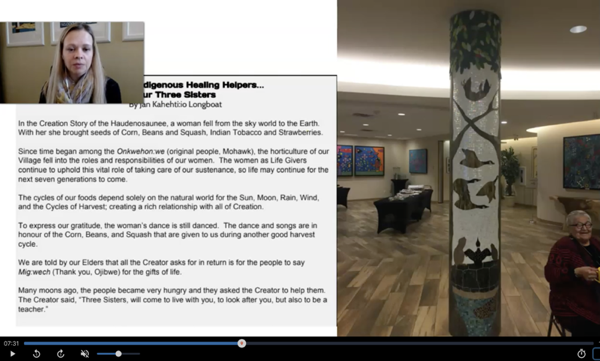
I was taking a picture of the art on the post, and happened to take a picture of Jan in the photo.
I didn’t know that until I met her later and then I visited her in Six Nations.
I created a video of my planting of the three sisters garden in our raised planting beds, and talked also about how nature has its time. It is important to plant at the right time, to weed at the right time, and to harvest at the right time. Even if it doesn’t fit in with other schedules, it reminds us that we are part of something greater, and that our role and our commitment with the land goes beyond classes or seasons. This sense of what we need to do and when we need to do it is inextricably bound with the rains, the winds, the sun. If we have many days of rain, we do not need to water. When strong winds are blowing, we may need to protect some of our weaker plants.
This lesson has come so clear to me through some hickory saplings that I received from a gardener, who had collected hickory nuts, with permission, from a sacred site in the community of the Chippewa of the Thames. These saplings were like little brown sticks, the nuts had sprouted in a white school tub filled with soil, and were left to me to care for. They would be returned and planted back in the community when they are strong enough. By caring for something, we enter into a contract with it; I agreed to do my best to support these trees. Over the winter, they were watered and lived in the library. In the spring, I worried that they were dead, but saw a few leaves pop up. They were, sadly, neglected in the library the initial weeks of COVID hit and I was in quarantine and couldn’t get them. When I finally retrieved them and brought them home, I put them in a window and watered them, and over 28 of them started sprouting small leaves. I had to wait until the weather was warm enough to repot them and have them outside, where they are under a spruce tree, in individual pots. When the forecast calls for hail, I need to make sure the plants are safe in my garage. But as the cold recedes, they need to be protected from the harsh sunlight as well. Daily moisture checks, and ensuring the pots don’t tip over are part of my commitment to these relatives.
As I was weeding the school front garden beds, and planting the corn, beans and squash seeds, I realized that this commitment stems from a deep sense of connection, of gratitude, and of hope. Gardening and tending to our plant relatives cultivates hope, as it is planning for a future, for a way to be in relationship with the land, with the insects, with the birds, with the animals, with the plants, with water, with the moon, and with Mother Earth that supports us all.
I know that these videos and shared stories do not create the relationships with Indigenous individuals and community members, which is imperative to moving forward and moving differently as a community, as a school, as a country. However, I hope that these experiences prepare students for those relationships. Our future will include sharing the medicines that have been harvested from the land to honor protocols and support relationships.
When I set out to describe my journey of the past few months, I didn’t realize how deeply entrenched the principles and teachings of Natural Curiosity were, but in writing them down, and reflecting on them, I see how they map out almost perfectly. I invite you to engage with these principles and see how they can work in your context.
References
Anderson, D. & Comay, J. (2017). Natural Curiosity 2nd Edition: A Resource for Educators – The Importance of Indigenous Perspectives in Children’s Environmental Inquiry. Toronto: The Laboratory School at the Dr. Eric Jackman Institute of Child Study, OISE. More information on the Natural Curiosity website.
Cathryn Mandoka (2010). Interview of Elder Jan Kahetiio Longboat. Our Roots Our Health 1(1) p. 7-10. Southern Ontario Aboriginal Diabetes Initiative. Available at: file:///Users/admin/Downloads/OROH%20Jan%20Cathryn.pdf
Recommended Resources
- Berry Magic by Betty Huffman and Teri Sloat
- Supplementary YouTube resources:
- Planting the Wild Garden by Kathryn O. Galbraith
- Ladybug Garden by Celia Godkin
- Sparrow Girl by Sara Pennypacker
- Flower Talk by Sarah C. Levine
- Strong Stories: The Three Sisters by Michelle Corneau
- Onondaga Seed Library
Additional Recommended Resource
The Raven and the Loon by Rachel and Sean Qitsualik-Tinsley, illustrated by Kim Smith
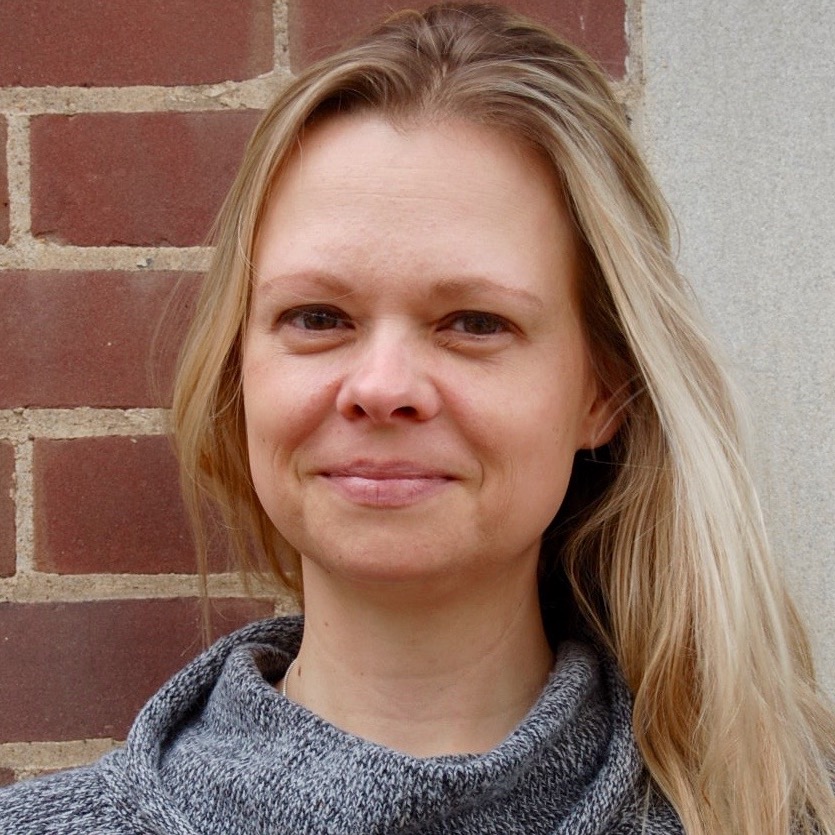
Krista Spence has worked at Dr. Eric Jackman Institute of Child Study Lab School in a variety of roles including Classroom Teacher, Teacher-Librarian, and Technology Integrator. She believes it is imperative to connect students with authentic Indigenous voices, to restore the students’ relationship to the land, and is constantly developing new lessons and approaches to meet these goals. Krista is endlessly grateful to the Indigenous teachers and Elders who have shared their knowledge and perspectives with her, and is always questioning her own place and role in this work. Krista is born of Estonian refugees, is active in supporting language learning and cultural development for young Estonians, and lives in Toronto with her family.